A great fire is just the start of our troubles.
It's also the CO2...
|
Climate Change may sound complicated,
yet the basic concept is simple:
Every day our atmosphere gets hotter.
On average, over any given period of time, i.e. months and years.
As warm sunlight pours in, ever greater concentrations of CO2 prevent more and more excess heat from radiating back to space.
We can reduce that heat in two basic ways.
1. Remove the excess CO2 from the sky.
Carbon Dioxide Removal technologies (CDR).
2. Stop putting new CO2 in the sky.
Fire Drones can play a crucial role in rapidly achieving both of those priceless goals.
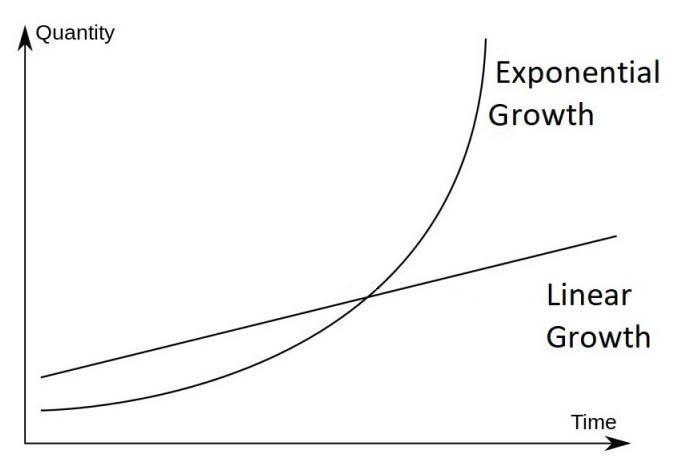
Quantity, Exponential Growth, Linear Growth, Time
ABOVE
Even though there is evidence that the rate of CO2 introduction into the atmosphere has declined, the effects of the ever increasing total CO2 load have not. For example, the wildfire season now starts earlier, and ravages much greater areas than ever before.
Please review the chart to the right >
The global average atmospheric CO2 concentration was at 416 ppm (parts per million) per NASA, early 2021.
NOAA — USA — The National Oceanic and Atmospheric Administration — announced that the new figure is 421 ppm. That is FIVE ppm higher than the ppm of 2021. It is the highest level in four million years. For comparison, atmospheric CO2 was essentially constant from 1750 to 1840—rock steady for over 90 years. BIOGEOSCIENCES • NOAA
|
...or Carbon Dioxide that is released that is even more detrimental than the fire itself.
"Extreme fires can release huge amounts of CO2 in a very short time. California fire experts estimate that the blazes that devastated Northern California's wine country in October 2017 emitted as much CO2 in one week as all of California's cars and trucks do over the course of a year."
"Exact quantities are difficult to calculate, but scientists estimate that wildfires emitted about 8 billion tons of CO2 per year for the past 20 years. In 2017, total global CO2 emissions reached 32.5 billion tons, per the International Energy Agency." INSIDE CLIMATE NEWS
If we don't remove it, that Carbon Dioxide will remain in our atmosphere for hundreds of years or longer. Every day, more CO2 is added than is removed by natural processes. Excess CO2 pushes the world's heat index up — and up.
That release — silent and unseen — is harmful in ways that vastly exceed the fire's destruction- and which will persist in their depredations long into the future.
The current focus is on mitigation and adaptation. To mitigate is to reduce emissions — to adapt is to learn to live in a hotter world.
The third focus must be the removal of CO2. That is a much higher bar to attain. There are several possibilities introduced in this work on how we can do exactly that, and how we can do it in just a few years of concerted effort. For example, could we engage our worldwide fleet of vehicles to continuously extract Carbon Dioxide from the atmosphere?
Global atmospheric Carbon Dioxide
levels are higher today than at any
point in the last four million years.
NPR
This unsustainable environmental denigration and its potential for breeding an unimaginably hotter planet far exceed the lost forest resources — as appalling a reality as that is.
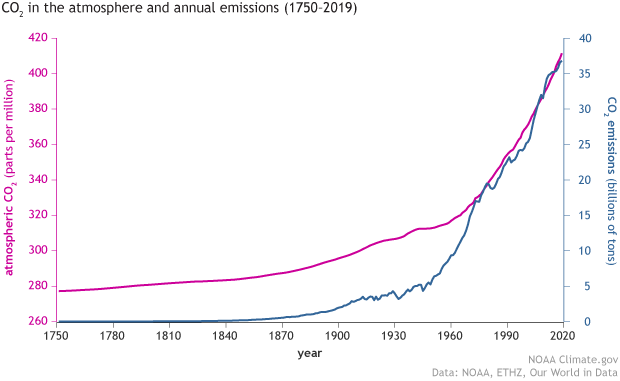
CO2 in the atmosphere and annual emissions. Atmospheric CO2 - parts per million. CO2 emissions (billions of US tons)
Note the accelerating rate of CO2 emissions. |
|
|

The nightly news reports the devastation of the fire, shows the homes burned to the ground,
the misery of inhabitants forced to flee and left with nothing — important reporting to be sure.
What is never reported are the huge volumes of planet-killing CO2 released into the sky.
|
|
| M E T H A N E |
Methane is 80 times more
potent
a planet killer than is CO2.
Unlike CO2, which we have the ability and technology to corral, were we to make it our number one world-wide priority, Methane cannot be contained once released from the vast and slowly melting Northern Tundra.
We all want to know about what we really are able to do about CO2.
It's getting hotter every year, and there are a great many scientists and engineers at work on this task.
Methane isn't exactly laying in wait in the tundra,
though we commonly speak as if it's so.
Niklas Keller, who has studied these dynamics, writes:
"Importantly, however, it DOES get produced with Nature's materials on hand as warming proceeds due to warmer temperatures."
A thicker active layer and higher temperatures in the subsoil promote the decay of organic material. This is conducive to the production of Methane.
Among the calamities we face due to Global Scorching, we all need to learn about the coming Methane release.
The ferocious danger of uncontrolled massive Methane release though has a timeline, and a point of no return for our civilization, for nature, and for our planet.
Should we cross that barrier, nothing else we do can prevent our planet from succumbing to the failure of everything we hold dear.
Paradoxically, the only leverage we have to prevent a planet-killing Methane release in our Northern Tundra is to match and defeat that release by greatly ramping down atmospheric CO2 emissions, and by greatly ramping up, capturing, and sequestering enormous amounts of atmospheric CO2.
https://fire-drones.com/FireDrones-8.html
Scroll down on Page 8 and discover the current message a variety of climate scientists are discovering and sharing with us.
It's an easy return here, to FireDrones-2.html.
|
|
|
Global Warming Game-Changer:
Plants Release Carbon
Sooner Than Expected
A new study reveals that the carbon stored by plants globally is more transient and vulnerable to climate change impacts than previously understood.
Led by Dr. Heather Graven from Imperial College London, the research shows that current climate models significantly underestimate how much CO2 is absorbed by vegetation annually and overestimate the duration it is retained, suggesting that carbon is released back into the atmosphere sooner than expected.
This indicates a need for rapid reduction in fossil fuel emissions and suggests limitations in the effectiveness of nature-based carbon removal strategies like large-scale tree planting.
New research indicates that plants absorb and release carbon dioxide faster than previously thought, challenging the effectiveness of nature-based carbon removal strategies and underscoring the urgency to cut fossil fuel emissions to combat climate change.
According to a new study, the global carbon stored by plants is more short-lived and susceptible to climate change than previously believed. These findings have significant implications for our understanding of nature’s role in mitigating climate change, particularly for nature-based carbon removal projects like mass tree-planting initiatives. |
|
|
|
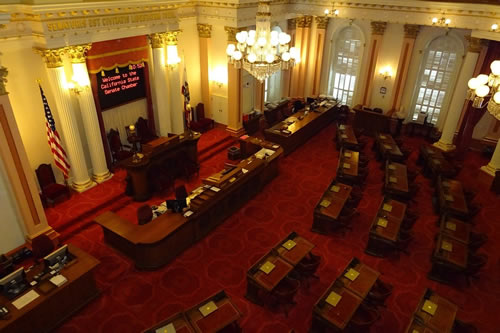 Image by Bishnu Sarangi from Pixabay Image by Bishnu Sarangi from Pixabay
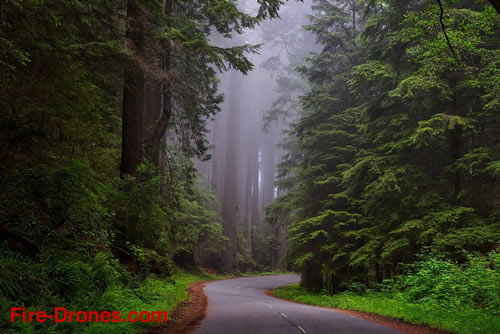
Image by David Mark from Pixabay
|
Could California lead the vanguard of
a global FireDrone implementation?
In the United States, California experiences the most widespread, dangerous and devastating wildfires by far. Every year the situation in the state becomes more dire.
By every measure, the costs in terms of public health, burned neighborhoods, state expenses for fighting the fire and for those displaced, lost forest beauty and grandeur, decimated wildlife, lost tourism revenue, and atmospheric CO2 release are overwhelming.
The cost to insurance providers is passed on to businesses and individuals. Taxes go up, and little by little, rural California becomes too expensive a locale to run a business, or live and work there. 33% — one third of the third largest state by area is forested land.
“We are seeing an increasing trend across California where people at risk of wildfires are being non-renewed by their insurer,” said state Insurance Commissioner Ricardo Lara in a statement in August (2020).
“I have heard from many local communities about how not being able to obtain insurance can create a domino effect for the local economy, affecting home sales and property taxes.”
MESSENGER MOUNTAIN NEWS
California has the most urgent need for a FireDrone umbrella. It boasts being the largest economy in the US, and the 5th largest economy in the world. It also enjoys a large scientific/technical sector to draw on.
It has the tax base and resources to single-handedly implement a robust FireDrone program. US Government participation could join such a real-world pilot enterprise with legislative, technical and financial support. |
|
|
|
Fire Drones will paradoxically allow for
a vast increase in controlled burns.
|
Won't FireDrones just be another stop-gap measure that must eventually fail?
Even if Fire Drones are wildly successful, some will say: "Yes, but you are only staving off the inevitable. Eventually, as our climate becomes warmer, there must come a point where even a superior airforce of Fire Drones will meet their match, and that technology too will fail."
It is crucial to appreciate that by preventing wildfires, those forest ranges that have been protected from burning will continue to extract CO2 from the atmosphere at a high rate.
Continuous extraction will meaningfully slow global atmospheric temperature rise. Combined with other removal technologies, there will come a day when net temperature lowering surpasses the daily anthropogenic CO2 increase curve.
With the same principle in play, new forests can be planted all over the world, and every tree that grows there will also be inhaling CO2, and thus lowering the planet's heat index.
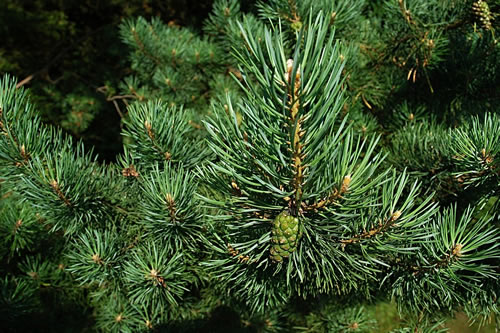
Image by Zdenek Chalupský from Pixabay
• Nations, states and even municipalities can focus on a two-pronged approach: Plant trees, and legislate against their wanton destruction.
• Companies that emit greenhouse gases can be asked to invest a portion of their profits to pay for the costs of planting new forests.
• The public can be persuaded to transition to vehicles which are at least Carbon Neutral — and at best automobiles which are Carbon Negative: Zero CO2 emissions, and they will remove CO2 from thin air as they tool about.
Fire Drones might catalyze a relatively
rapid cooling of our entire planet.
They may publicly be associated with their photogenic prowess at dropping water where it is needed — but they may also come to be known as the powerhouse technology that took a meaningfully large bite out of Global Warming caused by excess atmospheric CO2.
With a high rate of FireDrone introduction, we can expect atmospheric warming to stop, and cooling to begin, in as brief a period as ten years. That is predicated upon a World War II style highest-priority production commitment.
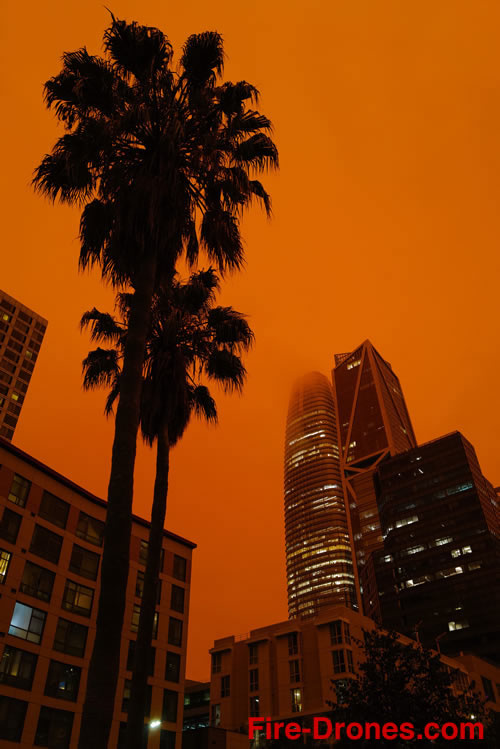 Photo by MILKOVÍ on Unsplash Photo by MILKOVÍ on Unsplash
Our goal is to provide a worldwide Fire Drone blanket for rapid intervention.
While most FireDrone Base Station installations will be located near areas of highest need, they will also be situated and have resources available in areas where wildfires are less frequent. |
Forests naturally produce
great amounts of underbrush.
Underbrush — and forests generally — have burned throughout the ages. Importantly, they burned when the earth's forest range was significantly larger than it is today.
JOURNAL OF ECOLOGY
It was not the issue it is today in our recent geological past — which began after the last Ice Age ended — as our climate was cooler, and large and out-of-control fires were rare.
Burns, both natural and human-mediated, are a necessary process as they clear excess underbrush out — and also germinate conifers. Germination occurs, however, only if there are many years of space between forest fires.
Otherwise, the resinous cones activated by a fire sprout seedlings which are then burned before they can develop cones. PNAS
Intentional removal of smaller trees prevents ignition of larger old growth trees when a fire occurs. Thinning generally promotes forest health. These practices are ongoing today— but the amount of area that needs to be treated for underbrush removal is well beyond the capacity of current efforts to address. OREGON FORESTS • USDA
"Globally, wildfire size, severity, and frequency have been increasing, as have related fatalities and taxpayer-funded firefighting costs. In most accessible forests, wildfire response prioritizes suppression because fires are easier and cheaper to contain when small.
In the United States, for example, 98% of wildfires are suppressed before reaching 120 hectares in size. But the 2% of wildfires that escape containment often burn under extreme weather conditions in fuel-loaded forests and account for 97% of fire-fighting costs and total area burned.
Changing climate and decades of fuel accumulation make efforts to suppress every fire dangerous, expensive, and ill advised."
- 2015 • SCIENCE
“Published science shows that pollution from human sources causes 98 percent of the heat of Climate Change and that human-caused Climate Change has doubled wildfires over natural levels in the western U.S." Patrick Gonzalez, Forest ecologist and Climate Change scientist at UC Berkeley." NY TIMES
“The California Department of Forestry and Fire Prevention estimates that of 33 million acres of forest in the state, 8 to 10 million acres need urgent mechanical thinning and burning to prevent [underbrush] disasters." NATIONAL GEOGRAPHIC
Once the process of natural underbrush burning was a welcome remedy. It reduced the amount of fuel that otherwise would have set off larger fires.
Today, underbrush accumulates as it always has — but when it burns without professional supervision, it ignites larger, hotter and more frequent fires than before, due to:
1) Insufficient prior underbrush clearing over large geographical areas.
2) A profoundly warming atmosphere.
It is a disturbing catch-22 today, with seemingly no good answer.
A global FireDrone system offers
four dynamic solutions to this dilemma:
1) They change the balance for the better, in that by preventing the world's forests from burning — and allowing extensive new forests to be planted — atmospheric temperatures will eventually fall due to the unprecedented amounts of CO2 that will be removed from the atmosphere.
2) Controlled burns can once again safely take place as long as the ratio between natural forest sequestration of CO2 and the release of a much smaller proportion of CO2 in the burn process prevails. With a more technologically advanced understanding of what is wanted and needed, burns will be the right treatment at the right time.
3) Fire Drones can also be on duty for all controlled burns, making certain that they do not exceed the planned burn area.
4) Controlled burns could now be safely managed in extremely remote or roadless areas and mountain tops — as Fire Drones can participate in any such effort.
FireDrone squads will confidently extinguish any wildfire, whether or not underbrush overload is a factor in that fire's genesis.
Inquiry to perfect Fire Drones is now ongoing.
Read about researchers dedicated to fleshing out the real-world math and science of Fire Drones devoted to actually extinguishing wildfires..... right here. |
|
|
|

Have you noticed??
Have you noticed that our skies are full of clouds lately?
Have you noticed that those clouds are
with us almost
every Summer day these days?
Have you noticed that all sorts of cloud types
inhabit
the sky these days... all at the same time?
Do you remember when the Summer sky often
had
no clouds in it at all...
or just one type of cloud?
The cloudy proliferation in our skies is the
result of a
profoundly warming atmosphere.
The more heat in our atmosphere,
the more cloud formation proliferates.
One might say...
"Well, that means we'll have less heat from
the Sun as we battle Global Scorching...
so that couldn't be a bad thing."
While there is a degree of truth to that, the much more salient point
is that clouds actually hold in heat ... heat which in previous decades
would escape to the sky and allow that heat to head on out to space.
Yes, our new cloudy skies are dramatic, impressive
...and even beautiful.
But, they portend an ominous
disruption
of our precious atmosphere...
and that's definitely not for the good.
- Warren Selinger |
|
|
| |
|
What you see below is a conceptual possibility.
We speak about it as if it already exists... it doesn't... not yet.
Please
keep checking back... maybe soon it will be on the job for real!
|
|
FireDrones are produced all over the world. Here are the
latest models on the Melbourne Australia production line.
 "Heart and Mind Saved The Future." • Vitaliia Kalmutska - Project Artist
"Heart and Mind Saved The Future." • Vitaliia Kalmutska - Project Artist |
|
FireDrones cruise high and fast. Hydrogen fuel cells are
one of two power sources for in-flight power generation.
H2
Two Hydrogen atoms joined together
will power Fire Drones and the future. 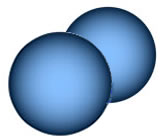
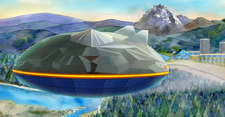 H2 — Hydrogen gas — is one of the two energy sources that keep a FireDrone aloft, able to navigate in three dimensions, and support a non-polluting and highly efficient flight platform. H2 — Hydrogen gas — is one of the two energy sources that keep a FireDrone aloft, able to navigate in three dimensions, and support a non-polluting and highly efficient flight platform.
H2 is created when two Hydrogen atoms join to form molecular Hydrogen. H2 has two protons and two electrons. It is the smallest molecule, and the most abundant element.
FireDrones are equipped with state-of-the-art Hydrogen fuel cells, which drive the rotors and power onboard systems. Besides energy, the other product a fuel cell emits is ordinary water — which a fire fighting FireDrone is always happy to pour into its onboard tanks.
|
Electricity from Hydrogen Fuel Cells
Hydrogen + Oxygen = Electricity + Water Vapor
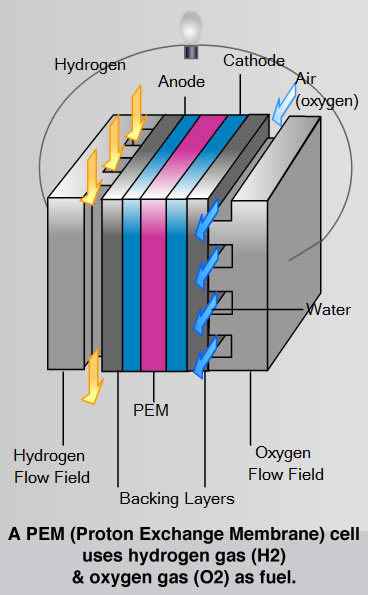 "A fuel cell is a device that converts chemical potential energy (energy stored in molecular bonds) into electrical energy. "A fuel cell is a device that converts chemical potential energy (energy stored in molecular bonds) into electrical energy.
The products of the reaction in the cell are water, electricity, and heat. This is a big improvement over internal combustion engines, coal burning power plants, and nuclear power plants, all of which produce harmful by-products.
Since O2 is readily available in the atmosphere, we only need to supply the fuel cell with H2 which can come from an electrolysis process." HYDROGENICS
There are four distinct advantages to utilizing clean Hydrogen fuel cells for FireDrone operation:
• They offer continuous and formidable power to drive all the craft's systems.
• They can refuel within minutes and be ready for the next mission.
• They produce zero emissions — except for ordinary water.
• They can store more than three times the energy of ordinary batteries. |
|
These are all powered by Hydrogen and they don't pollute our atmosphere with CO2. |
|
|
|
|
|
|
|
Fire Drones |
|
|
|
In-flight solar electricity is another power source.
It
will
insure that no FireDrone ever runs out of juice.
Look closely — those tiny solar cells
are resting on a soap bubble.
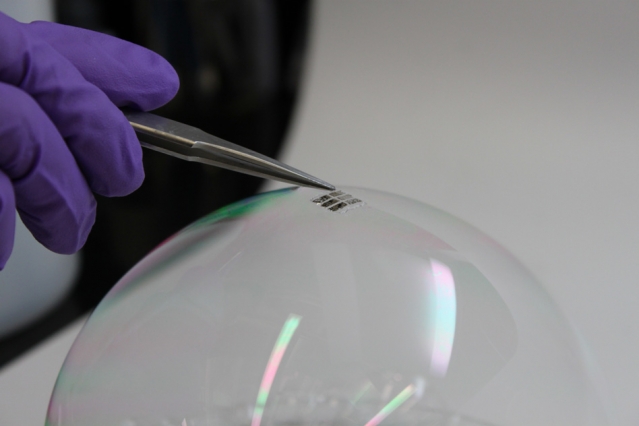
High energy conversion flexible solar cells.
Photo: Joel Jean and Anna Osherov
The top surface of a FireDrone is covered with photovoltaic cells which are 400 times more productive than those found on roof-top solar panels — and lighter than a feather.
Consider the implications of this technological leap, and how it might be the perfect energy source for a FireDrone.
There are many variables, but on average,
28 to 34 current-design solar panels will completely power the average home.
Now, the average solar panel is 65" x 39" or 5.4 feet by 3.25 feet. That works out to 17.5 square feet per panel. 34 panels would then be 595 square feet. Divide that by 400 and you will see that you will only need 1.5 square feet of MIT solar cells to power your entire home.
Solar energy generated by these cells would no longer require that a home or building not be surrounded with shade trees or neighboring structures, as is generally indicated with current rooftop solar panels. Low light may still generate all the power that is needed to achieve a viable energy threshold.
If this research bears fruit, it is a convincing possibility for a FireDrone power source in flight, and also for less costly energy generation for any power requirements:
"The new type of solar is coming. In the next five years, we'll have access to more readily deployable, lighter, very inexpensive solar energy, generating electricity at less than
2¢ per kilowatt-hour."
- Vladimir Bulovic
MIT-nano • Spring, 2019. |
FireDrones might utilize sunlight to fly.
A FireDrone continuously recharges in-flight, and can rest on the ground in an open area or on a lake, and recharge directly from sunlight.
This cooperative synergy will insure that sufficient power on demand is always instantly available for swift flight — and the work of hovering over fields and forests on fire and extinguishing those fires — in order to achieve their mission's stated goal.
FireDrones co-powered by a 400X in-flight solar-cell create a beneficial ratio between sunlight converted to electrical energy while soaring to extinguish a wildfire at 180 mph.
What is important when considering this energy-generating breakthrough is the possibility that these modalities could be utilized to completely power or co-generate energy for vehicles of all types — including great airborne fleets of Fire Drones.
Cars, trucks, trains, buses, boats and ships, Maglevs and both private and commercial aircraft might run on this unprecedented solar power technology. Combined with lightweight batteries to supply night propulsion — and satisfy peak energy demand requirements at any time — this could be an historic milestone.
If these were MIT solar cells, they might supply all the energy needs of 50 homes.
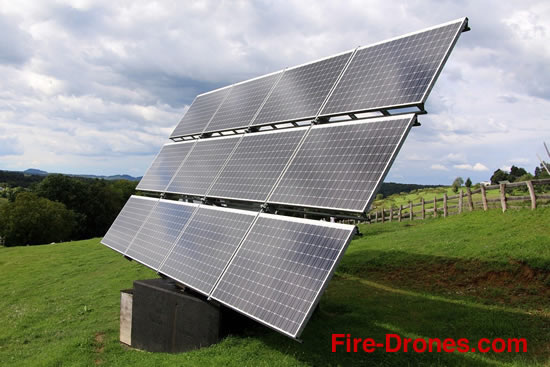
Image by atimedia from Pixabay
That these might be utilized to power Fire Drones is useful, both in their base station charging, as well as by inflight energy generation. Just as on target is their ability to not only reduce societal energy costs — but also to allow us to quickly transition away from a fossil fuel / nuclear powered civilization.
Imagine fielding an inexpensive, sustainable, clean and green energy system in a shorter time period than anyone dreamed possible. |
|
|
|
Propulsion and lift is achieved
through hundreds of powerful rotors...

Four main front-facing FireDrone rotor system. VECTOR. BLUEPRINT.
State of the Art Propulsion Systems
There are four larger and more powerful embedded rotors on the front-facing surface.
They provide potent forward propulsion for fast travel while in formation with other Fire Drones on their way to or from the wildfire zone.
Rear exit ducts permit ramjet-style flight capability for maximum velocity.
|
...which dot the top of the FireDrone.
Unlike the typical drones the world is now familiar with, none of the rotors protrude above the surface of the FireDrone.
This design streamlines the surface and produces less drag, less noise, and less danger to humans and birds.
It also allows Fire Drones, AmbaDrones and SafeDrones to slip through any forest without slashing the tree limbs — or running aground themselves.
Each rotor in and by itself is powerful; when added together, they are more powerful than any commercial drones currently in service.
All rotors can swivel in their sockets, and act in concert — directed by sophisticated state-of-the-art flight computers.
This confers an exquisite three dimensional mobility to every FireDrone. They can move through the sky at 180 MPH; they can stop on a dime in mid-air and hover; they can go up, or down, or on an angle — and they can even fly 'backwards.'
Take a look at what designboom is doing with their remarkable "Bladeless Drone." "The bladeless drone solves three main problems of today’s common drones: air humming, exposed blades and wind." |
|
|
|
LiDAR shows a FireDrone what the terrain looks like.
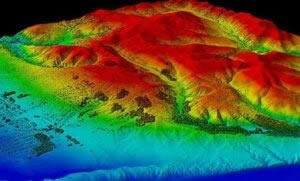
LiDAR sees the terrain shape.
|
LiDAR and other advanced topography instruments will allow Fire Drones to know precisely what the situation on the ground is and how they can best respond in order to quell a wildfire.
All Fire Drones utilize Light Detection and Ranging (LiDAR) technology.
LiDAR is able to provide precise realtime data regarding the topography in which a FireDrone is operating, which in turn insures safe and accurate operation in the field. LiDAR can "see" through dense forest and heavy smoke. NOAA |
|
|
|
The shell of a FireDrone is constructed
from
3D Graphene.
It is the lightest and strongest material known to science.
MIT Researchers:
"A team of researchers at MIT (the Massachusetts Institute of Technology) has designed one of the strongest lightweight materials known, by compressing and fusing flakes of graphene, a two-dimensional form of Carbon. The new material, a sponge-like configuration with a density of just 5 percent, can have a strength 10 times that of steel."
MIT EDU • Graphene: The Movie
A FireDrone will be heavy when full with its complement of 3,000 lbs. of water. When empty, it is deceivingly light. It is also designed to be maximally rugged, as it will be comprised of the strongest yet lightest components available.
By utilizing 3D Graphene and hBN (hexogonal Boron Nitride), and other miracle materials, Fire Drones can be imbued with a toughness that will stand up over time, as they confront the harsh conditions posed by a wildfire.
JOURNAL OF APPLIED PHYSICS •
ACS PUBLICATIONS: 3D GRAPHENE MATERIALS
|
Cheap to produce,
and powerful in action!
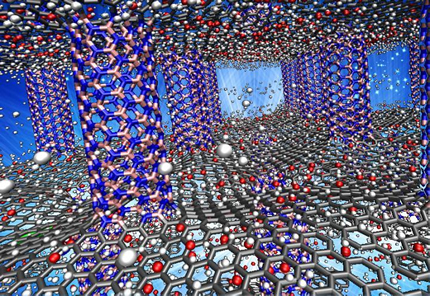
Energy.Gov: Public Domain
3D Graphene is a material that made its debut on the world stage just in time. It is incredibly strong — and unbelievably light weight.
According to Rice University researchers, 3D Graphene will be cheap as the junk we throw away, and it will be a major component in thousands of applications — including addressing the Climate Emergency.
PASSIVE COMPONENTS |
|
|
|
Would Fire Drones actually work?
|
 |
Let's ask scientists and engineers to weigh in on the matter. If there is an indication that Fire Drones might provide benefit, let's build a prototype, send it over a forest, put out a small controlled test fire, and extrapolate what five hundred or five thousand might do.
If there is a sense that this technology might in fact have a beneficial part to play, then let's invest in it, improve it and field it.
If there is no clear result, we can say we did our best and then put our focus elsewhere. We will learn useful data even if we fail. |
|
|
Make a Correction or a Suggestion
|
Do you have a suggestion for improvement of this presentation?
Do you have an idea relating to Fire Drones that would advance the discussion?
Is there something in the science presented here that you feel is either incorrect or incomplete?
We want to correct any erroneous statement, and we invite you to advise. Please offer a scholarly citation if one is available.
Write us with your advice or corrections. Your name will not be made public.
With your submission, you agree to the possibility that your correction or idea may be incorporated into this site and its narrative. |
|
|
|
|
Earth's forests can trap much of the excess CO2 in the sky.
"How to grow a forest fast."
Click the pic to see how...
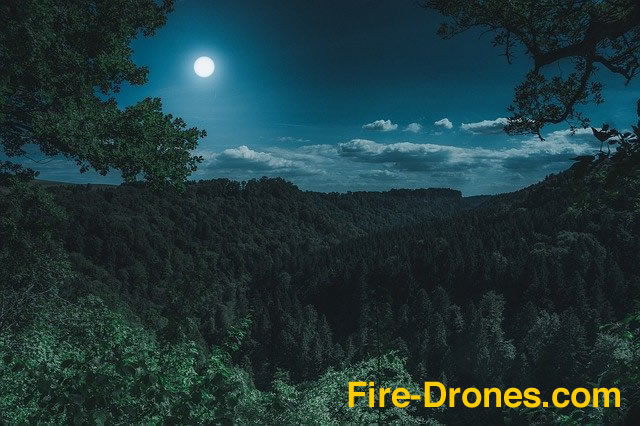
Photo by Florian Kurz on Pixabay
Support The Trillion Trees Initiative
1T • UNITED STATES CONGRESS • YALE ENVIRONMENT
"1t.org exists to connect, empower and mobilize a global reforestation community of millions, unleashing their potential to act at an unprecedented scale and speed, to ensure the conservation and restoration of one trillion trees within this decade."
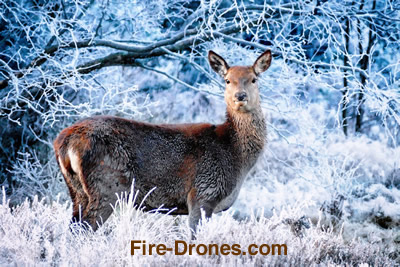
You know the frustration when you hear about Climate Change: "I want to make a difference — but really — what can I do about it?"
Fire Drones are a concrete plan which you can choose to wholeheartedly support. Speak or write to your elected representatives and ask them to do feasibility studies. Write to those in the vanguard of Climate Emergency solutions and ask them to consider this option.
Contribute your time and energy so that we communicate a powerful message for this plan to end wildfires, and as well prevent countless billions of tons of unwanted CO2 from entering the atmosphere. Concerned citizens taking concerted action is a truly powerful force.
|
Fire Drone navies can become one of
Earth's
most important insurance policies.
With Fire Drones on duty, we can prevent forest, prairie and tundra from burning no matter where on Earth wildfires may occur.
That same system can also protect all existing forests and tundra so they can continue to sequester CO2. That is arguably as important as any goal the world community has ever been called upon to achieve.
We can present it as a goal as worthy as any of our cherished commitments to democracy, freedom, justice, opportunity and free expression. Without altering our current relationship with our precious forests and tundra, we, as a civilization, will perish.
We can ask governments and international agencies to legally protect all forests everywhere from over-logging and the wanton cutting down of billions of trees each year. We can intervene in a timely fashion to stop the decimation of our natural wild heritage.
There are 20 million active-duty soldiers in the world today, supported by mammoth expenditures. Could we invite one-tenth of that number to the calling of reforestation? Could we invite governments to rise to the occasion and support these initiatives committed to no-excuse forest replanting?
We can do all this for the forest — preserve its grandeur, its natural beauty, its mediation of our climate, its flora and fauna, its recreational opportunity, its poignant reminder of what is important and it's inherent sacred commitment to care for the world's precious human inhabitants.
Thinking outside the box is good.
Taking action outside the box is better.
It's up to you. Get involved, speak up, and talk to your elected representatives. Bring the conversation around to the challenge at a family gathering, and ask all those in your circle to consider that everyone's voice is needed to reverse course.
_____________________________________
"The best time to plant a tree was 20 years ago. The second best time is now."
— Chinese Proverb
We can plant limitless square miles of new forest within the space of a decade.
That will take us a long way to removing the excess CO2 now poisoning the sky.
Yet that will only be true if we can stop our forests from burning, and that is precisely the promise and guarantee of a fully deployed FireDrone technology. |
|
|
|
|